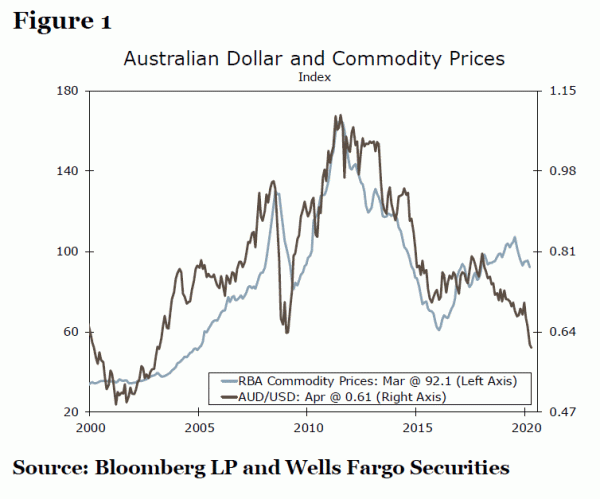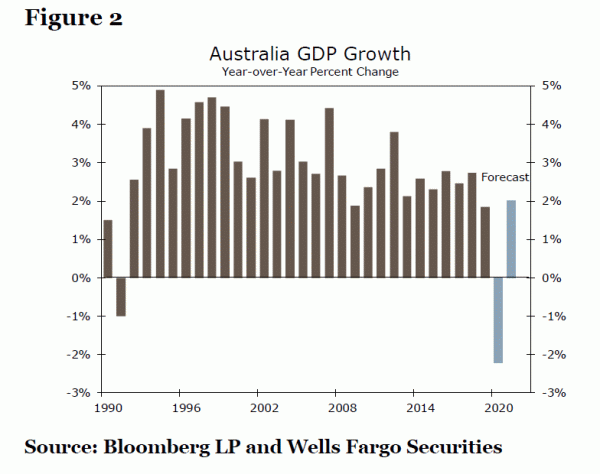Executive Summary
- Australia’s economic situation has deteriorated significantly in recent months on the back of the coronavirus outbreak and some weakness in commodity prices. Given the recent developments, we now look for the Australian economy to contract 2.2% for the full-year of 2020, marking the first recession since the early 1990s.
- The Australian government announced large fiscal stimulus measures aimed at supporting businesses and households in response to the recent pandemic. These include additional fiscal spending of A$194B (almost 10% of GDP), as well as measures to support the flow of credit. On the monetary policy front, the central bank slashed its Cash Rate to an all-time low of 0.25% in March and deployed several unconventional policy measures including a quantitative easing program.
- The Australian dollar has weakened over 13% since the start of the year, and other than the Norwegian krone, is the worst performing G10 currency this year. We expect some further decline in the Australian dollar before eventual stabilization.
Australia’s Economy Gloomiest Since 1991
In recent months there have been significant developments in the Australian economy, with the outlook weakening sharply amid the coronavirus outbreak and with commodity prices under some pressure. Most recently, the Australian government joined its international peers in imposing tougher measures to contain the spread of coronavirus that has infected over 5,700 individuals across the country. The government extended its shutdown of non-essential services by banning travel overseas, closing most businesses and restricting large events such as funerals and weddings. With non-essential services and businesses closing, the labor market is likely to be significantly depressed in months ahead. On balance, these major disruptions to economic activity are likely to drag on growth for the full-year 2020.
Aside from the coronavirus, lower commodity prices could also have an adverse effect on the Australian economy. Coal and iron ore prices of various grades have fallen since their recent 2019 peak, and the RBA’s commodity price index (in U.S. dollar terms) is down 14% since the middle of last year (Figure 1). Still, the declines in Australia’s key commodity prices have been less dramatic than the fall in some other commodity prices—as one example, the CRB commodities price index is down some 32% just since the start of 2020. Evolving trends in Australia’s commodity prices will be an important factor for the economy and the currency, given that Australia is a relatively open economy and is significantly influenced by the prices for commodities, given that bulk commodities, such as iron ore, metallurgical coal and thermal coal account for around 53% of exports.
Indeed, among the reasons Australia has been able to avoid recession of the past several years are a sustained period of elevated commodity prices and a strong performing Chinese economy. Given that around 38% of Australia’s merchandise exports go to China, Australia is substantially affected by the performance of China’s economy, both positively and negatively. With China the epicenter of the coronavirus and forecast to contract around 1% this year, a recession for Australia’s most important trading partner will likely create a significant headwind for Australian GDP growth. Indeed, we now look for real GDP in Australia to tumble 2.2% this year, which would be the first recession since the early 1990s. Under the assumption the virus is contained in a timely manner, and that any return of the virus is less severe, we look for a modest bounce back in growth over 2021 (Figure 2). That said, we acknowledge the timing and extent of eventual Australian economic recovery remains subject to significant uncertainty.
Australia Unloads the Budget Bazooka
In response to the negative economic consequences from the pandemic, the government unveiled fiscal stimulus measures to support the economy. The packages will provide aid to businesses and households affected by the pandemic, as well as balance-sheet support to ensure the flow of credit in the economy. Specifically, the measures include a new subsidy program to support employees and businesses known as the JobKeeper Payment, which amounts to roughly 6.5% of GDP. This is designed to help businesses—many of which are struggling to retain their employees—cover the costs of their employees’ wages. Among other support directed for businesses and individuals include:
- Temporary cash flow support to small and medium sized businesses as well as not-forprofit organizations. (~1.6% of GDP)
- Introducing a time-limited incentive to support business investment and economic growth by accelerating depreciation deductions. (~0.2% of GDP)
- Temporarily expanding eligibility to income support payments and establishing a new, time-limited coronavirus supplement. (~0.7% of GDP)
- Wage assistance to help small businesses retain their apprentices and trainees. (~0.1% of GDP)
Including the latest announcements from the Australian government, the cumulative fiscal stimulus now stands at A$194B. This amounts to roughly 10% of Australian GDP. Even though the government deployed various additional fiscal stimulus measures, we view Australia’s AAA credit rating as safe for now. Prior to the recent pandemic, Australian government finances were in solid shape. For 2019, the IMF estimated the general government budget deficit was 0.7% of GDP and gross general government debt was around 42% of GDP. Only if there was an extended economic downturn do we believe the rating agencies would more seriously consider lowering Australia’s credit rating.
RBA Cuts Cash Rate Effectively to Zero
In addition, as the outbreak has intensified the Reserve Bank of Australia (RBA) has also acted to support the economy and financial markets. Of note, the RBA reduced its Cash Rate a cumulative 50 bps during March to 0.25%, which Governor Lowe suggested was the effective lower bound for rates. The RBA announced various other significant measures aimed to supporting the economy and financial markets, including:
- Yield targeting on the three-year Australian government bond of around 0.25% through purchases of government bonds in the secondary market. The latest data indicate the RBA has purchased A$36B of bonds through this program so far.
- A three-year funding facility of at least A$90B for the banking system, to allow banks to have access to additional funding, aimed at lending for small-to-medium-sized businesses.
- Conducting one- and three-month repo operations daily until further notice, in addition to longer-term repo operations (six-months or longer) as long as market conditions warrant.
- Establishing a US$60B FX swap line with the Fed designed to improved access to U.S. dollar liquidity.
Despite these efforts from the RBA as well as fiscal policy makers, we doubt they will be sufficient to avoid a deep slump in growth. Given that the central bank has largely depleted it conventional interest rate tools, we expect it will likely hold its Cash Rate at 0.25% for an extended period of time. We think it is unlikely the central bank will cut rates below zero given policymakers’ comments pointing to limited appetite for negative interest rates in Australia. However, if the virus continues to spread and the economic impact deepens, further monetary easing is possible. While it is not clear what form such easing would take, a further expansion of the central bank’s bond purchase program appears to be a reasonable possibility.
A Tough Start to the Year for the Australian Dollar
Since the start of 2020 the Australian dollar has fallen over 13%, and is one of the worst performing currencies among its G10 peers this year. We do expect some further decline in the Australian dollar in the near term, with the dual threat of the coronavirus outbreak and potential for lower commodity prices headwinds for the Australian dollar, before the currency eventually stabilizes and recovers over the longer-term as the effects of the virus dissipate and the U.S. dollar softens. We see the risks around this outlook as broadly balanced as we believe the current value of the Australian dollar already reflects an extremely negative economic scenario, though we acknowledge a moderate downside bias to our target low. The risk of even further weakness should largely depend on how China navigates the crisis as well as trends in Australia’s key commodity prices.















